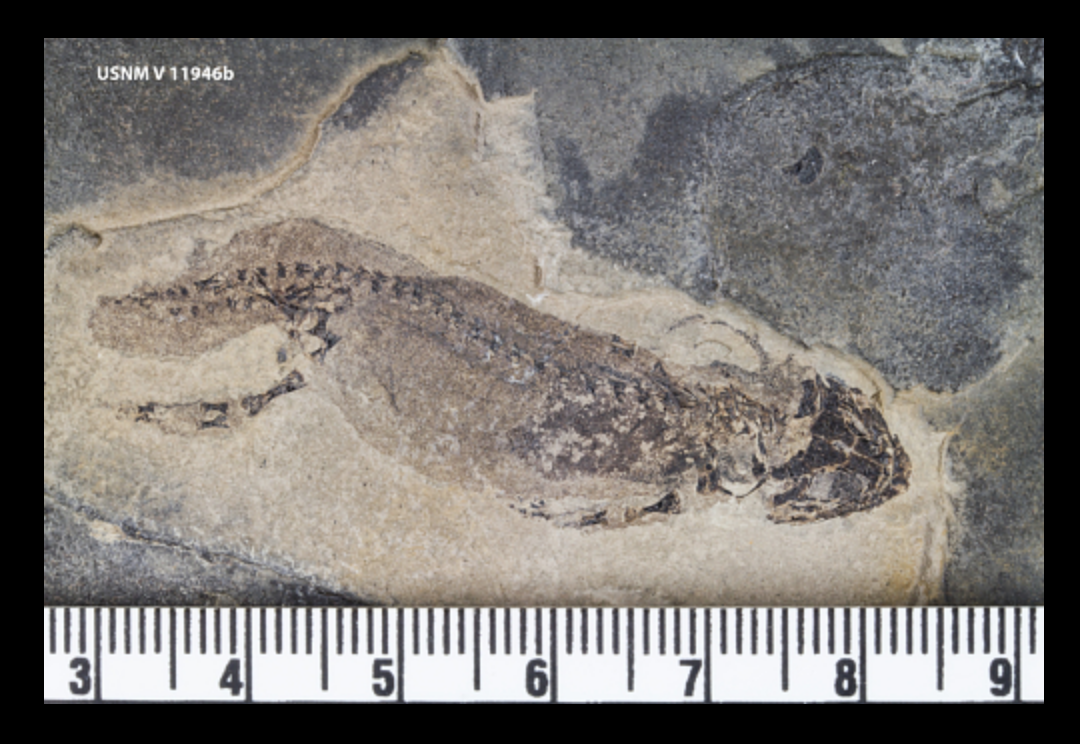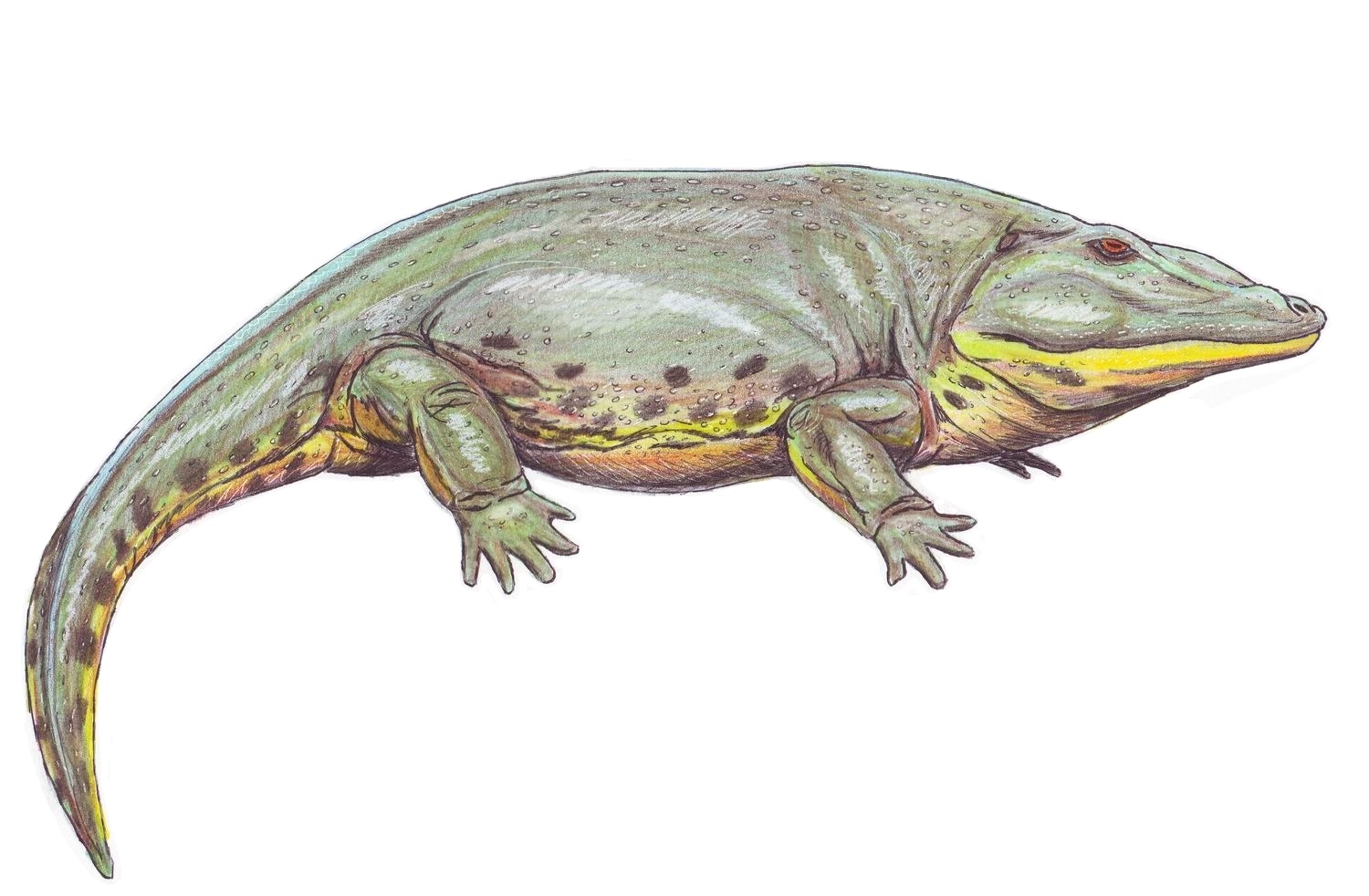|
Branchiosaurus
''Branchiosaurus'' (from el, βράγχιον , 'gill' and el, σαῦρος , 'lizard') is a genus of small, lightly built early prehistoric amphibians. Fossils have been discovered in strata dating from the late Pennsylvanian Epoch to the Permian Period. The taxa may be invalid; the material referred to the genus may be juvenile specimens of larger amphibians. This tiny amphibian was very similar to the Rachitomi, differing primarily in size. Other distinguishing characteristics include a cartilaginous, less ossified skeleton and a shorter skull. Clear traces of gills are present in many fossilized samples, hence the name. Originally thought to have vertebrae distinct from rachitomous vertebrae, it was placed in a separate order named Phyllospondyli ("leaf vertebrae"). Later analysis of growth stages showed increasing ossification in larger specimens, which showed that at least some of the species was the larval stage of much larger rachitomes like ''Eryops'', while o ... [...More Info...] [...Related Items...] OR: [Wikipedia] [Google] [Baidu] |
Branchiosaurids
Branchiosauridae is an extinct family of small amphibamiform temnospondyls with external gills and an overall juvenile appearance. The family has been characterized by hundreds of well-preserved specimens from the Permo-Carboniferous of Middle Europe.Schoch, R.R. 2008. The intrarelationships and evolutionary history of the temnospondyl family branchiosauridae. Journal of Systematic Palaeontology. 6(4):409-431. Specimens represent well defined ontogenetic stages and thus the taxon has been described to display paedomorphy (perennibranchiate). However, more recent work has revealed branchiosaurid taxa that display metamorphosing trajectories.Schoch, R.R. and Frobisch, N.B. 2006. Alternative Pathways in an Extinct Amphibian Clade. Evolution. 60(7):1467-1475 The name Branchiosauridae (“Branchio” in Ancient Greek denoting gills and “saurus” meaning lizard) refers to the retention of gills. Geological/paleoenvironmental information Branchiosaurids mostly inhabited Permo-Carbo ... [...More Info...] [...Related Items...] OR: [Wikipedia] [Google] [Baidu] |
Branchiosaurus BW
''Branchiosaurus'' (from el, βράγχιον , 'gill' and el, σαῦρος , 'lizard') is a genus of small, lightly built early prehistoric amphibians. Fossils have been discovered in strata dating from the late Pennsylvanian Epoch to the Permian Period. The taxa may be invalid; the material referred to the genus may be juvenile specimens of larger amphibians. This tiny amphibian was very similar to the Rachitomi, differing primarily in size. Other distinguishing characteristics include a cartilaginous, less ossified skeleton and a shorter skull. Clear traces of gill A gill () is a respiratory organ that many aquatic organisms use to extract dissolved oxygen from water and to excrete carbon dioxide. The gills of some species, such as hermit crabs, have adapted to allow respiration on land provided they are ...s are present in many fossilized samples, hence the name. Originally thought to have vertebrae distinct from rachitomous vertebrae, it was placed in a separat ... [...More Info...] [...Related Items...] OR: [Wikipedia] [Google] [Baidu] |
Phyllospondyli
The Phyllospondyli is a now abandoned term for a series of small, poorly ossified fossils of labyrinthodont amphibians from the Paleozoic. The groups was proposed as an order on the basis if their vertebrae, which was either consisting of neural arches over an otherwise unossified notocord or consisting of thin-walled, ring-shaped intercentra topped by the neural arch. The name ''pyllospondily'' is from Greek, "leaf vertebrae".Case, E.C. (1946): A Census of the determinable Genera of Stegocephalia. ''Transactions of the American Philosophical Society'', vol. 35, Part 4, pp 325-42Phyllospondyli section of article/ref> While the group originally was based on the shape of the vertebrae, common in older classification of labyrinthodonts, several families was at times assigned to it based on skull characters. All members were more or less salamander-like in body outline, with weak, poorly ossified limbs, four fingers to the hand and a more or less round skull when seen from above. Rema ... [...More Info...] [...Related Items...] OR: [Wikipedia] [Google] [Baidu] |
Brachiosaurus
''Brachiosaurus'' () is a genus of sauropod dinosaur that lived in North America during the Late Jurassic, about 154to 150million years ago. It was first described by American paleontologist Elmer S. Riggs in 1903 from fossils found in the Colorado River valley in western Colorado, United States. Riggs named the dinosaur ''Brachiosaurus altithorax''; the generic name is Greek for "arm lizard", in reference to its proportionately long arms, and the specific name means "deep chest". ''Brachiosaurus'' is estimated to have been between 18 and 22 meters (59 and 72ft) long; body mass estimates of the subadult holotype specimen range from 28.3 to 46.9 metric tons (31.2 and 51.7 short tons). It had a disproportionately long neck, small skull, and large overall size, all of which are typical for sauropods. Atypically, ''Brachiosaurus'' had longer forelimbs than hindlimbs, which resulted in a steeply inclined trunk, and a proportionally shorter tail. ''Brachiosaurus'' is the name ... [...More Info...] [...Related Items...] OR: [Wikipedia] [Google] [Baidu] |
Prehistoric Amphibian
This list of prehistoric amphibians is an attempt to create a comprehensive listing of all Genus, genera from the fossil record that have ever been considered to be amphibians, excluding purely vernacular terms. The list includes all commonly accepted genera, but also genera that are now considered invalid, doubtful (''nomen dubium, nomina dubia''), or were not formally published (''nomen nudum, nomina nuda''), as well as synonym (zoology), junior synonyms of more established names, and genera that are no longer considered amphibians. Modern forms are excluded from this list. The list currently includes 454 names. Naming conventions and terminology Naming conventions and terminology follow the International Code of Zoological Nomenclature. Technical terms used include: * Synonym (zoology), Junior synonym: A name which describes the same taxon as a previously published name. If two or more genera are formally designated and the type (zoology), type specimens are later assigned to th ... [...More Info...] [...Related Items...] OR: [Wikipedia] [Google] [Baidu] |
Vertebrae
The spinal column, a defining synapomorphy shared by nearly all vertebrates,Hagfish are believed to have secondarily lost their spinal column is a moderately flexible series of vertebrae (singular vertebra), each constituting a characteristic irregular bone whose complex structure is composed primarily of bone, and secondarily of hyaline cartilage. They show variation in the proportion contributed by these two tissue types; such variations correlate on one hand with the cerebral/caudal rank (i.e., location within the vertebral column, backbone), and on the other with phylogenetic differences among the vertebrate taxon, taxa. The basic configuration of a vertebra varies, but the bone is its ''body'', with the central part of the body constituting the ''centrum''. The upper (closer to) and lower (further from), respectively, the cranium and its central nervous system surfaces of the vertebra body support attachment to the intervertebral discs. The posterior part of a vertebra fo ... [...More Info...] [...Related Items...] OR: [Wikipedia] [Google] [Baidu] |
Niederkirchen Beds
Niederkirchen is a municipality in the district of Kaiserslautern, in Rhineland-Palatinate, western Germany Germany,, officially the Federal Republic of Germany, is a country in Central Europe. It is the second most populous country in Europe after Russia, and the most populous member state of the European Union. Germany is situated betwe .... References Kaiserslautern (district) {{Kaiserslautern-geo-stub ... [...More Info...] [...Related Items...] OR: [Wikipedia] [Google] [Baidu] |
Paedomorphic
Neoteny (), also called juvenilization,Montagu, A. (1989). Growing Young. Bergin & Garvey: CT. is the delaying or slowing of the physiological, or somatic, development of an organism, typically an animal. Neoteny is found in modern humans compared to other primates. In progenesis or paedogenesis, sexual development is accelerated. Both neoteny and progenesis result in paedomorphism (as having the form typical of children) or paedomorphosis (changing towards forms typical of children), a type of heterochrony. It is the retention in adults of traits previously seen only in the young. Such retention is important in evolutionary biology, domestication and evolutionary developmental biology. Some authors define paedomorphism as the retention of larval traits, as seen in salamanders.Schell, S. C. ''Handbook of Trematodes of North America North of Mexico'', 1985, pg. 22 History and etymology The origins of the concept of neoteny have been traced to the Bible (as argued by Ashley Monta ... [...More Info...] [...Related Items...] OR: [Wikipedia] [Google] [Baidu] |
Eryops
''Eryops'' (; from Greek , , 'drawn-out' + , , 'face', because most of its skull was in front of its eyes) is a genus of extinct, amphibious temnospondyls. It contains the single species , the fossils of which are found mainly in early Permian (about 295 million years ago) rocks of the Texas Red Beds, located in Archer County, Texas. Fossils have also been found in late Carboniferous period rocks from New Mexico. Several complete skeletons of ''Eryops'' have been found in lower Permian rocks, but skull bones and teeth are its most common fossils. Description ''Eryops'' averaged a little over long and could grow up to , making them among the largest land animals of their time. Adults weighed between . The skull was proportionately large, being broad and flat and reaching lengths of . It had an enormous mouth with many curved teeth like the frog. Its teeth had enamel with a folded pattern, leading to its early classification as a "labyrinthodont" ("maze toothed"). The sh ... [...More Info...] [...Related Items...] OR: [Wikipedia] [Google] [Baidu] |
Larval Stage
A larva (; plural larvae ) is a distinct juvenile form many animals undergo before metamorphosis into adults. Animals with indirect development such as insects, amphibians, or cnidarians typically have a larval phase of their life cycle. The larva's appearance is generally very different from the adult form (''e.g.'' caterpillars and butterflies) including different unique structures and organs that do not occur in the adult form. Their diet may also be considerably different. Larvae are frequently adapted to different environments than adults. For example, some larvae such as tadpoles live almost exclusively in aquatic environments, but can live outside water as adult frogs. By living in a distinct environment, larvae may be given shelter from predators and reduce competition for resources with the adult population. Animals in the larval stage will consume food to fuel their transition into the adult form. In some organisms like polychaetes and barnacles, adults are immobile ... [...More Info...] [...Related Items...] OR: [Wikipedia] [Google] [Baidu] |
Scientific Classification
Taxonomy is the practice and science of categorization or classification. A taxonomy (or taxonomical classification) is a scheme of classification, especially a hierarchical classification, in which things are organized into groups or types. Among other things, a taxonomy can be used to organize and index knowledge (stored as documents, articles, videos, etc.), such as in the form of a library classification system, or a search engine taxonomy, so that users can more easily find the information they are searching for. Many taxonomies are hierarchies (and thus, have an intrinsic tree structure), but not all are. Originally, taxonomy referred only to the categorisation of organisms or a particular categorisation of organisms. In a wider, more general sense, it may refer to a categorisation of things or concepts, as well as to the principles underlying such a categorisation. Taxonomy organizes taxonomic units known as "taxa" (singular "taxon")." Taxonomy is different from m ... [...More Info...] [...Related Items...] OR: [Wikipedia] [Google] [Baidu] |
Bone
A bone is a Stiffness, rigid Organ (biology), organ that constitutes part of the skeleton in most vertebrate animals. Bones protect the various other organs of the body, produce red blood cell, red and white blood cells, store minerals, provide structure and support for the body, and enable animal locomotion, mobility. Bones come in a variety of shapes and sizes and have complex internal and external structures. They are lightweight yet strong and hard and serve multiple Function (biology), functions. Bone tissue (osseous tissue), which is also called bone in the mass noun, uncountable sense of that word, is hard tissue, a type of specialized connective tissue. It has a honeycomb-like matrix (biology), matrix internally, which helps to give the bone rigidity. Bone tissue is made up of different types of bone cells. Osteoblasts and osteocytes are involved in the formation and mineralization (biology), mineralization of bone; osteoclasts are involved in the bone resorption, resor ... [...More Info...] [...Related Items...] OR: [Wikipedia] [Google] [Baidu] |







